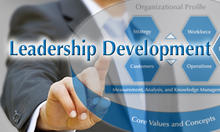Blogrige
The Official Baldrige Blog


Baldrige Executive Fellow, 2018
Charles (“Chuck”) Callahan is president of Memorial Health System (MHS) Hospital Group and president and CEO of Memorial Medical Center. He is also a Baldrige Executive Fellow who participated in the 2018 cohort. Like other Baldrige Fellows, Callahan completed a capstone project synthesizing and applying his learning as part of the year-long executive leadership program. Callahan titled his capstone, “Advancing an Innovation Strategy for Health System High Performance.”
In a recent interview for this blog, Callahan described a critical insight that inspired him to focus on health care system “high performance” in his capstone project:
My purpose for engaging in the Baldrige Executive Fellow Program was to advance personal and organizational high performance. As a health care executive, I found it was humbling to acknowledge that there was no consistently accepted definition of “high performance” in our industry (Ahluwalia, et al, 2017). However, one cross-industry standard (i.e., the Baldrige Excellence Framework) offers clear guidance: “ever-higher levels of organizational and individual performance, including quality, productivity, innovation rate, and cycle time.”
I could point to numerous efforts and successes in addressing most of these features in my organization, but we had no systematic approach toward innovation rate as a key element of performance. That insight sparked my work to develop an innovation strategy that complemented our mission and vision, built on our strengths, addressed our weaknesses, and fostered new solutions in a rapidly changing marketplace.
In the interview, Callahan also talked about how he benefited from the cross-sector perspectives of other Baldrige Fellows as he reached key milestones in developing his health system innovation strategy:
The fellowship cohorts are filled with talented national leaders, and in my class many came from health care. So, one milestone was affirmation that my organization was not unique in the kinds of challenges we were facing or the types of solutions we were exploring. In addition, Fellows from the manufacturing and financial services sectors had very valuable perspectives on customer focus and organizational agility—things that health care has not historically optimized. These elements certainly shaped my thinking regarding the design of an innovation system. I would say too that the feedback and support of the Fellow experience also leads to a more expansive—you might say integrative/systematic—project than I originally envisioned.
Asked how the changes he’s leading in this organization could improve its performance for the long term, Callahan responded,
The timing of my Baldrige fellowship year coincided with a major refresh of our corporate strategic plan and an organizational restructure prompted by an impending acquisition of a mid-size regional hospital system. I’m proud to say that innovation now very tangibly appears in our strategic plan and in our organizational structure, with a chief quality and innovation officer role that links our historical strengths in “sustaining innovation” approaches like Lean Six Sigma with new “breakthrough” and “disruptive” innovation elements like Lean start-up and even venture capital relationships. My project work has yielded a template that integrates a broader away of strategic and operational improvement constructs in a way that fits with our culture.
Callahan then described how his deeper understanding of the Baldrige framework will impact his organizational leadership and management approaches going forward:
I gained a much better appreciation for the essence and flexibility of the Baldrige framework. Our previous organizational approach was to use the Baldrige framework as an external compliance system, much like the Joint Commission accreditation standards in our industry ... that is, figure out how to comply with a set of rules designed by a national expert panel, and you would improve. In contrast, through the Fellows program and learning about Baldrige Award recipient organizations across many sectors, I came to realize that the Baldrige Criteria for Performance Excellence (part of the Baldrige framework) are not rules to follow at all. Rather, they are a set of integrated principles that are designed to foster an organization’s development of its own internal system for excellence, matched to its unique mission, vision, culture, and customer requirements.
I was amazed at how different the Baldrige Award recipient organizations really were, and how their uniqueness actually was magnified through their Baldrige learning cycle history. This is the opposite of a compliance system where uniqueness and variation are actually reduced, not magnified and celebrated. This was a major eureka moment from my Baldrige Fellow experience.
Callahan also explained what makes the Baldrige framework particularly useful as a tool for leading an organization:
Since the Baldrige is not a compliance system but, rather, a set of principles, the use of “what” and “how” questions to foster improvement is very important. It forces in leaders an internal sense of introspection, reflection, and clarifying dialogue to get to the root of your business. This is much different than other systems that reinforce your focus on an external set of mandated “to-do’s.” That type of introspective approach assisted our strategic planning and organizational structure redesign this year for sure.
When asked to identify a key benefit of the Baldrige framework for other health care organizations, Callahan responded, “the central focus on integration,” adding,
In our industry, after a couple of decades of working to link organizational strategy to actions, efforts to results, and managers to the workforce, I now hear a lot of talk among health care leaders about how to work more as integrated and optimized systems. That is, how do we transition from federations of loosely aligned, affiliated sites into cohesive efficient and effective systems serving populations across broad regions?
I think the Baldrige framework offers an important perspective on this critical topic that is very timely for health care organizations pursuing excellence in these challenging times.
Join a Community of Visionary Leaders

Become a Baldrige Executive Fellow
The Baldrige Executive Fellows Program is a hands-on leadership development program that will propel your organization to higher levels of performance. Learn from a cohort of senior decision makers and Baldrige Award recipients and emerge with a broader perspective on how to achieve performance excellence for your organization, stimulate innovation, and build the knowledge and capabilities necessary for organizational sustainability.
What Executive Fellows Are Saying | Apply Today (2020–2021 cohort)





